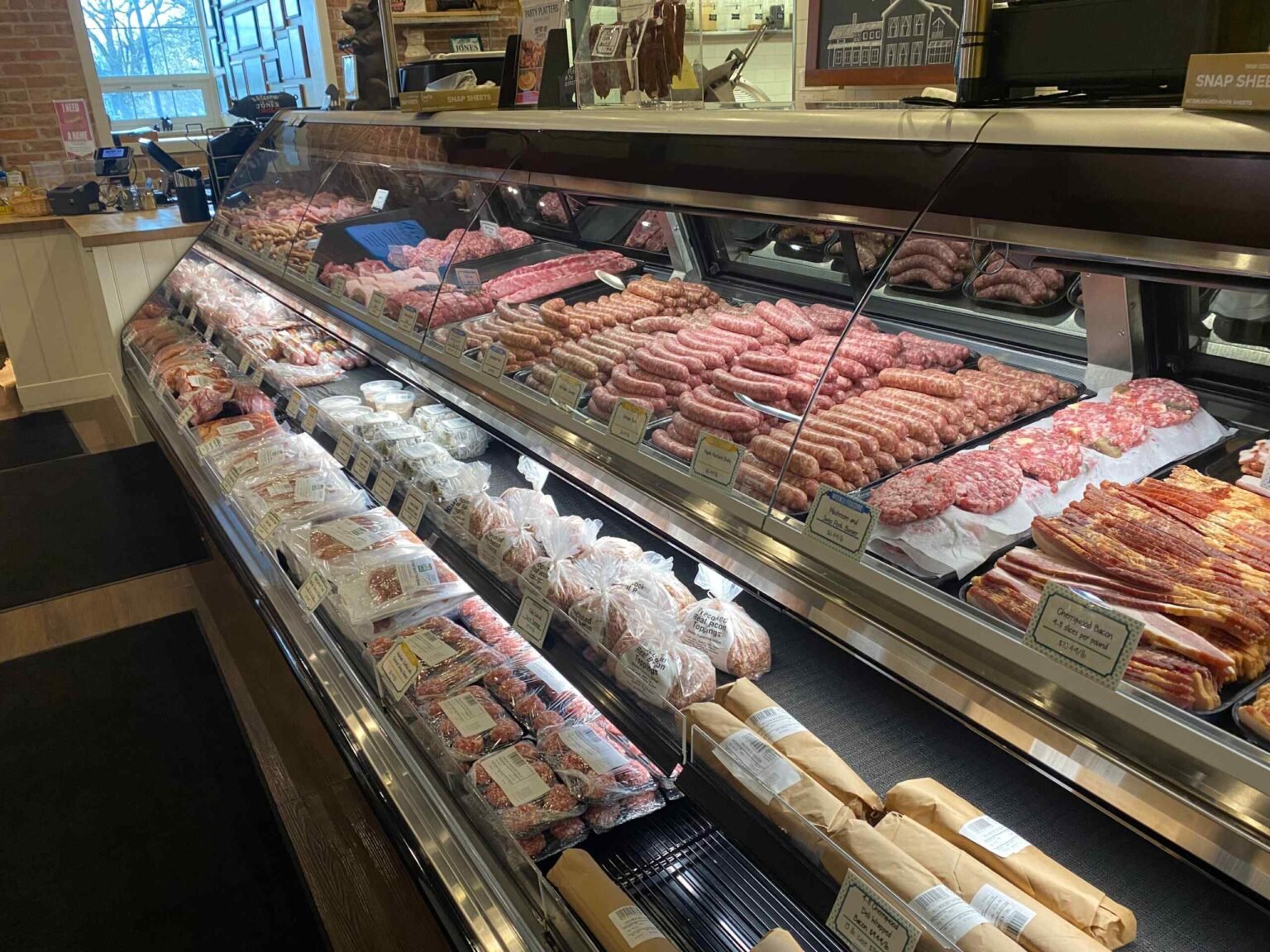Ever grabbed a pack of deli meat, then stared blankly at the sandwich you’re making? How much is enough? Too much? The struggle is real! But don’t worry, I have the answers to achieve perfect deli meat portions.
Let’s make sandwich-building a breeze, shall we?
What is a Standard Serving Size of Deli Meat?

Piling up the perfect sandwich? Let’s talk about how much deli meat you should be throwing on that bread. A standard serving size is about 2 to 3 ounces.
Sure, it sounds skimpy at first, but trust me, it’s just right to layer up your sandwich without making it a tower of Pisa situation.
Plus, getting a handle on this helps big time if you’re trying to keep track of what you eat or you’re plotting out the snacks for your next party.
Ever wondered what 2 to 3 ounces of deli meat looks like? If the meat is sliced thin, you’re looking at about three to four slices.
Go for thicker cuts, and you’ll have about two to three slices to play with. Here’s a quick breakdown to keep things crystal clear:
- Very Thin (1/16′): You can stack about 4-5 slices.
- Thin (1/8′): 3-4 slices should do the trick.
- Standard (1/4′): 2-3 slices will make the cut.
- Thick (1/3′): You’re down to 1-2 slices.
- Extra Thick (1/2′): One slice is plenty.
This handy dandy table isn’t just for kicks—it’s your secret weapon when you’re standing there in the deli aisle, trying to figure out how much meat to grab.
So next time you’re prepping for a get-together or just making your midweek lunches, remember, the thickness of those slices can make all the difference. No more playing guessing games with your sandwich layers!
Why Accurate Deli Meat Measurements Matter

Accurate measurements for deli meats are crucial to ensuring a satisfying meal. Have you ever had a sandwich where the meat was sliced too thick, making it tough to bite through, or so thin it got lost among the other ingredients? Here’s why getting it just right is key.
Take a scenario where you’re hosting a party and need to whip up 20 sandwiches. If those meat slices are on the thicker side, you might find yourself short, unable to feed all your guests.
Flip that situation to slices that are too thin, and suddenly your sandwiches are more bread than meat, likely leaving everyone still hungry. Getting that perfect slice ensures you hit the mark—right amount, right taste.
And hey, let’s talk about the money aspect. Deli meats can make your wallet feel a bit light, so you definitely want to ensure you’re getting your money’s worth.
Imagine you need half a pound of sliced chicken for a recipe, but end up with slices that are off the mark.
Too much, and you’ve overspent; too little, and it’s another frustrating trip to the store. It’s not just about staying on budget, it’s about keeping your meal plans intact.
Now, consider the flavor and texture of your meal. Some deli meats are a culinary delight when sliced paper-thin, enhancing their flavor and making them melt in your mouth, while others need to be a bit thicker to really feel satisfying and juicy.
Accurate slicing caters to these nuances, making sure each bite is as delightful as you expect.
Deli Meat Weights and Measures

When hitting the deli counter, knowing standard weights and measures is key. It helps you get the right amount of meat for your needs, whether you’re grabbing a few slices for a sandwich or stocking up for the week.
Common Weights for Sliced Deli Meats:
- Ounce (oz): A lightweight option often used for a single sandwich slice.
- Pound (lb): A common bulk purchase weight that could serve multiple meals.
When purchasing deli meats, it’s essential to consider the thickness of the slices, as this can affect the overall weight and quantity you receive. Slicing preferences for different types of deli meats might vary:
- Thin slices are ideal for sandwiches or platters.
- Thicker cuts might be preferred for dicing and adding to salads or recipes.
Accurate scales are vital in delis to ensure both the business and consumer are exchanging fair values. Make it a habit to visually confirm that the scale starts at zero before your deli meat is weighed.
For pre-packaged meats, always check the net weight listed on the label, which indicates the weight of the meat without packaging. It’s worthwhile knowing that certain packaging materials can be included in the gross weight and must not be factored into the cost of the product itself.
Typical Measurements for Pre-Packaged Meats:
- Grams (g) and kilograms (kg): Often used on packages, with 1000 grams equaling 1 kilogram.
When selecting your deli portion sizes, remember that standard serving size per person for a main dish is generally about 2 to 3 ounces.
Deli Meat Measurement Chart by Type

Ready to nail down exactly how much deli meat to grab for your next meal or shindig? Let’s dive into this handy chart that spells out the perfect portions.
Whether you’re throwing a casual get-together or just prepping your weekly meals, we’ve got you covered with this quick table.
| Meat Type | Sandwiches (per sandwich) | Platters (per person) | Other Uses (per serving) |
|---|---|---|---|
| Turkey Breast | 2-3 oz | 1/2 lb | Salads: 1-2 oz |
| Ham | 2-3 oz | 1/2 lb | Diced for Recipes: 1/4 cup |
| Roast Beef | 2-3 oz | 1/2 lb | Slices for Entrees: 3-4 oz |
| Salami | 1-2 oz | 1/4 lb | Chopped for Antipasto: 1/4 cup |
| Prosciutto & Specialty Meats | – | 1/4 lb | Main Course: 3-4 oz <br> With Melon or Figs: 1-2 oz |
Isn’t it simpler when you know exactly how much to buy? This chart isn’t just a reference; it’s your secret weapon for making sure you’ve got just the right amount of deli meat, whether you’re feeding two or twenty.
Say goodbye to last-minute store runs and hello to a perfectly planned menu!
Average Deli Meat Costs

You’ve probably noticed that deli meat prices aren’t all created equal. For instance, staples like turkey and ham won’t break the bank—expect to shell out somewhere between $5 to $10 per pound.
But if your taste buds are hankering for something like prosciutto or salami, be prepared to fork over a bit more, as these can set you back $15 to $30 per pound.
| Deli Meat Type | Price Range (per pound) |
|---|---|
| Roast Beef | $10 – $14 |
| Turkey Breast | $8 – $12 |
| Ham | $6 – $10 |
| Salami | $7 – $12 |
| Bologna | $5 – $8 |
| Specialty Meats* | $12 – $20+ |
Have you ever wondered if there’s a real difference between buying your meat pre-packaged and getting it sliced fresh at the deli counter?
Here’s the scoop: pre-packaged deli meats usually come cheaper, particularly with those tempting sale tags.
But if you swing by the deli counter, you might find that the freshness and the ability to buy just the amount you need can actually cut down on waste and save you money over time.
Who doesn’t love a good deal? Keep your eyes peeled for weekly sales and promotions at your local grocery store.
These are golden opportunities to stock up on deli meats without denting your wallet. And hey, if you’re part of a store loyalty program, you might just snag some special pricing or extra discounts.
How to Order Deli Meat by Thickness

Want to nail the perfect deli meat thickness for your next meal? Let’s dive straight into how you can master this seemingly tricky task without breaking a sweat.
Ever stood at the deli counter feeling slightly clueless about how to describe your ideal meat slice? You’re not alone. Here’s the lowdown: deli meats can be sliced thin, medium, or thick.
If you’re aiming for a sandwich that’s light on the palate, go for thin slices, often referred to as ‘shaved.’ These are about 1/16 inch thick and won’t overpower your sandwich’s other flavors.
Prefer a sandwich with a bit more heft? Medium slices are your best bet. At about 1/8 inch thick, they add the perfect chew without being too bulky.
And if you’re in the mood to toss some meat into a salad or just munch on it directly from the plate, thick slices, about 1/4 inch thick, will do the trick.
Now, here’s a tip: you don’t need to memorize these measurements. When you’re ordering, just chat with the deli clerk.
Try saying something like, “Can I get it thin enough for a light sandwich?” or “I’d like thick slices for a chunky bite.” It’s all about communicating your needs clearly—trust me, they’ve heard it all!
Curious about how to make your deli visits even smoother? Here’s a thought: why not describe what you’re planning to make with the deli meat?
It’s a great way to give the clerk a clear picture, and who knows, they might just have some tasty suggestions up their sleeve!
Adjusting Portion Sizes Based on Dietary Needs
Are you on a mission to drop some pounds? You might want to cut back on the deli slices. Or perhaps you’re an athlete who’s upping their protein game? Then, bumping up those portions could be the way to go.
Getting the hang of adjusting your deli meat intake can be a bit of a puzzle, but think of it as fine-tuning your meals to sync perfectly with your diet plan.
Check out this straightforward guide on portion sizes tailored to various dietary goals:
- Weight Loss: Stick to about 1-2 ounces of deli meat.
- Weight Maintenance: 2-3 ounces should do the trick.
- Muscle Gain: Aim for 3-4 ounces.
- Low-Sodium Diet: Keep it to 1-2 ounces, but also pick low-sodium options.
- Keto Diet: 2-3 ounces are your best bet.
These suggestions are merely jumping-off points. You’ve got to factor in your activity levels, age, and any specific dietary needs you might have.
Especially if you’re watching your sodium intake, not only should you monitor the quantity but also opt for deli meats that are lower in sodium.
When tweaking your portions, remember it’s not all about the amount. The quality of the deli meat matters big time.
Choose cuts that are leaner, have less sodium, and are free from nasty extras like added sugars and artificial preservatives.
This way, you’re not just meeting your dietary goals—you’re also making smarter, healthier food choices.



